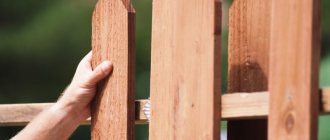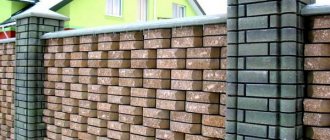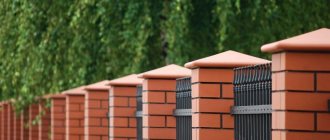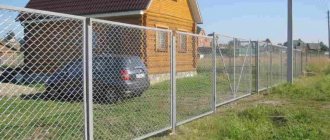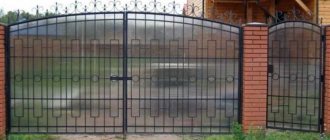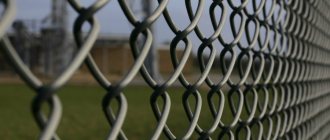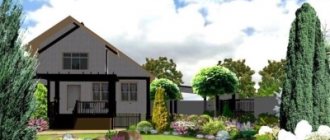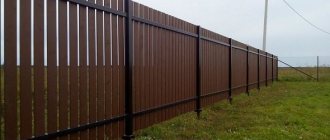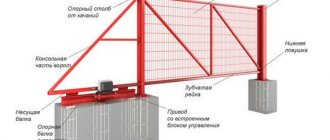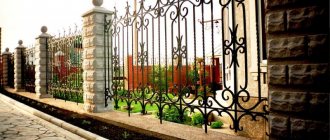The quality of the supports determines the service life and reliability of the entire fence. Wooden fence posts deserve special attention, namely the purchase of well-dried raw materials. Unlike metal supports, they require pre-treatment and periodic maintenance. But with proper use and compliance with the stages of the construction process, they can compete with any other material.
Advantages and disadvantages of wooden poles
Wooden poles must be treated with an antiseptic so that they do not rot.
The wood has sufficient strength and hardness not to be destroyed by mechanical forces, and the material resists compression and bending loads. Shrinkage can be predicted in advance, since the size changes less along the fibers than across it. The conductivity of moisture, steam, and sound depends on the direction of the fibrous structure.
Wooden fence posts have a certain viscosity, so they can hold fastenings and fixing elements inside, and counter strips for locking tongues can be embedded into the body of the posts. The wear resistance of the material is determined by the fact that wood, in the presence of impregnations, is not destroyed by sudden changes in temperature.
Dry wood does not conduct electricity, so you should not be afraid of a shock if the gate and wicket have an automatic drive with an electric motor.
The use of wood for fence posts is justified by its low cost compared to metal, brickwork, and prefabricated reinforced concrete elements. Fence supports are easy to install, so the owner of the site can dig the elements to a depth with his own hands and perform concreting.
The lower part of the pillar is treated with bitumen mastic
Other advantages of the material:
- availability of purchase;
- beautiful appearance;
- environmental cleanliness.
The disadvantage is that over time, the impregnating layers lose their relevance, and you have to regularly treat and paint the surface. Wood serves enough, but its service life is shorter than that of other materials. The load-bearing capacity does not allow hanging heavy sections or concrete slabs on the pillars.
It is necessary to dig the pillars into the ground by first wrapping the lower part with roofing material or coating it with molten bitumen so that the pillars do not become unusable due to rot. The top of the elements is shaped like a cone to speed up the drainage of water.
How to treat wooden posts before burying them in the ground
Coating with antiseptics alone is not enough to protect the underground part of the pillar. It must be treated with waterproofing compounds. Suitable for this:
- Liquid molten bitumen;
- Polymer special coating mastic;
- Tar;
- Technical development.
To waterproof the underground part of the pillar, liquid coating is needed. It fits tightly to the material and creates reliable protection. Roll wraps are ineffective in this case.
Selection and processing of pillars
Treating wood with fire
Before installing wooden fence posts, it is necessary to treat them with antiseptics to extend their service life. The lower part, which will be buried in the ground, must be protected from soil moisture. In addition to modern methods, the folk method of fire treatment is used.
Procedure:
- to maintain the firing boundary, wrap the barrel with foil 25 cm wide;
- light a fire;
- the barrel is brought to the flame and rotated for uniform firing for 10 - 15 minutes;
- after blackness and cracks appear, indicating charring, the pole is removed from the fire.
For firing in modern conditions, gas burners or a blowtorch flame are used. The height of the wooden fence can be 1.5 - 2.0 m. Depending on this, trunks are selected to reduce non-working waste. There are fences that are larger in height, but the supports cannot be spliced along the length.
Recommended types of wood
Oak is the most suitable material for outdoor posts.
Oak tables last the longest; they will last for several decades without loss of quality. Trunks of other species are inferior to oak in terms of service life and require regular renewal of the surface.
Recommendations for types of wood:
- in first place after oak are larch, mulberry, pine, acacia, ash;
- Spruce and fir are considered lower in quality;
- Maple, birch, aspen, linden, and alder were considered unsuitable.
Slightly rotting and high-density hard rocks are suitable. Trunks last a long time if the wood contains resinous substances that prevent the absorption of moisture and damage from bugs and microorganisms.
Planed beams for posts are available for sale. Select specimens with a small number of knots, since such places weaken the strength. They check fallen and rotting branches; it is better to discard such bars. They check the geometric dimensions, pay attention to the curvature of the trunk, darkened areas, and the presence of moss on the surface of the element.
Methods and means of protecting supports from moisture
Copper sulfate solution for treating the above-ground part of the post
If wooden fence posts are placed in the ground, the lower part comes into contact with the soil and absorbs water from it in rainy weather or during periods of rising moisture levels. They are wrapped with moisture-proof materials, coated with liquid molten bitumen, tar or modern polymer-based mastics. Apply 2 – 3 layers, leaving a day between applications to harden.
The above-ground part also needs to be treated with antiseptics:
- an aqueous composition (5 - 7%) of iron or copper sulfate;
- sodium fluoride;
- creosote oil;
- zinc chloride.
Hexachlorane and chlorophos are used against weevils and borers that infect the material. Impregnation with pyrilax will protect against fire. Water repellents will protect against moisture saturation. The products are applied as an independent layer; sometimes complex compositions of bioprimers are used, which already contain protection from moisture.
What to pay attention to
Others will call these disadvantages, but we will rephrase them as features that need to be taken into account when choosing wooden posts for effective and long-lasting results:
- Wood is sensitive to moisture, both from the soil and from rain, fog, and melted snow. In order for the product to retain its shape and characteristics, it is necessary to treat it with waterproofing compounds.
- Protection of wooden posts from rotting in the ground is ensured by applying antiseptic impregnations to the lower part of the product and its additional waterproofing.
- Wood has a short service life compared to concrete and metal, but it can be extended with proper care and timely processing of the product.
- Wooden supports can only support lightweight fencing structures; they are not suitable for forged and concrete structures.
Manufacturing and preparation
If the wood is not cut, it must be dried in natural conditions, folded under a canopy. Drying time is about a year. For construction, specimens that have completely completed the drying period are used.
The bark is removed from the surface. To do this, use an axe, a scraper, or a shovel. The trunks are placed in a vertical position so that there is a reliable stop at the bottom. The debarking is removed from the top, gradually lowering so as not to damage the body of the trunk.
If knots protrude from the sides, they are cleared with a plane, ax, or saw. To grind the surface, use an electric tool or use sandpaper attached to a block. A carving is made on the area of the pillar and a convex ornament is made, if such is provided for in the project.
Material calculation
In the question of how to build a wooden fence for your dacha yourself, you can use boards from unused wooden pallets, or purchase a new picket fence.
The standard thickness of the wooden boards from which pallets are assembled is 15 mm.
The support pillars will also be made of wood. To install a wooden fence you will need beams, the size of which is 50x50 mm. The number of pillars is determined taking into account the selected distance between them and the perimeter of the site.
The number of boards for transverse fastening on support posts along the length should be 2 times the perimeter of the fenced area. Naturally, you need to calculate this length with a margin. The minimum length of such wooden beams must correspond to the distance between the supporting structures.
The construction of wooden fences involves the use of the following materials:
- wooden poles;
- beams for transverse fastening on support posts;
- fence;
- Long nails will be needed for structural strength.
To install the pillars you will need sand or gravel. The number of fence boards is determined by the following formula: the perimeter of the enclosed area is divided by the sum of the estimated distance between two picket fences and the width of one element.
Taking into account the length, width and thickness of one board, the required volume for the purchase of a finished picket fence is determined.
How to install
Mark the line using pegs and an elastic cord. To do this, use a hydraulic level and use a level. Right angles are found using a theodolite, or using the method of aspect ratio of a right triangle.
A distance of 1.5 - 2.0 meters is made between the pillars, a post is placed on both sides for the gate, and two more supports are prepared for the gate. If a small passage is made in the gate leaf, the posts for the gate are not marked.
The depth of the pillars is taken depending on the weight of the filling of the spans and the properties of the soil. The freezing mark of the soil and the height of rising moisture are taken into account. In heaving soils (clays), the installation depth is 1.0 - 1.2 m, and in dry soils (chernozem, sand, sandy loam) it would be correct to bury it at 0.8 - 0.9 m.
First, they clear the area along the trajectory of the fence, then remove 10–20 cm of fertile soil. A garden drill is used to excavate the soil, but you can dig a hole manually using a bayonet shovel.
Step-by-step instructions:
- Sand (5 cm) and crushed stone (10 cm) are poured into the bottom of the pit, the layers are compacted and water is poured over them to compact them. The materials play the role of drainage and stop the rise of liquid.
- The column is aligned vertically; you can use a plumb line. It is better to carry out the work together or fix the support in the mounting position with spacers.
- The solution is poured into the hole, trying to fill it so that there are no voids. During the procedure, a deep electric vibrator is used. If it is not there, the mass is bayoneted with a metal pin during installation to expel air bubbles.
Constantly check the correct installation using a tensioned cord, and also coordinate the verticality with a plumb line.
The solution is prepared at a concentration of 1:3 (cement, sand). It should be more liquid than thick so that it can flow down to the bottom of the post.
Typical mistakes in installing wooden poles
You need to dig in the pillars with the butt area up so that the wood does not absorb water.
If you install the trunk with the butt down, water will intensively rise from the soil along the pillar due to spontaneous osmosis. The support must be placed with the butt facing up in order to disrupt the natural process and reduce moisture suction.
Impregnation with antiseptics and other preparations is done on dried wood, the humidity of which does not exceed 15%. Violation of the rule leads to a decrease in the effectiveness of trunk pre-treatment. If there is water in the pits, it is sucked out with a pump and removed with buckets in order to place supports in the pit without liquid.
They try to bury the heel of the pillar in the sand-crushed stone mixture. A metal support is nailed to the bottom of the wooden trunk to increase strength and stability.
Overhead line supports
The installation of wooden supports is carried out on class 3 overhead lines, where the rated operating voltage is 1 kV or less. The most common are intermediate supports that serve to support wires. In addition, they perceive wind loads, as well as the weight of the reinforcement and their own. On their own, they may not be able to withstand the forces generated along the line if a break occurs. This load is perceived by anchor supports with additional struts located along the axis of the overhead line. They mainly serve to create tension on a section of wires. To absorb lateral loads, anchor supports are used with struts or “legs” located in a perpendicular direction.
There are also corner supports that absorb longitudinal and lateral loads. They are installed to turn lines.
Installation of wooden supports is carried out with precise markings of places, and assembly is carried out with a tight fit of parts.


